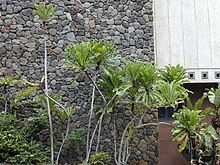| Ficus pseudopalma | |
|---|---|

| |
| Scientific classification | |
| Kingdom: | Plantae |
| Clade: | Tracheophytes |
| Clade: | Angiosperms |
| Clade: | Eudicots |
| Clade: | Rosids |
| Order: | Rosales |
| Family: | Moraceae |
| Genus: | Ficus |
| Subgenus: | F. subg. Sycomorus |
| Species: | F. pseudopalma |
| Binomial name | |
| Ficus pseudopalma Blanco | |
| Synonyms | |
|
Ficus blancoi Elmer | |
Ficus pseudopalma is a species of fig, (subgenus Sycamorus) in the mulberry family (Moraceae). It is known by the common names Philippine fig, dracaena fig, and palm-leaf fig. In nature it is endemic to the Philippines, especially the island of Luzon. It is known elsewhere as an ornamental plant.
This is a shrub or rarely branching small tree growing erect with a naked unbranched mesocaul stem topped with a cluster of wavey-edged leaves to give it the appearance of a palm. Indeed, the species name pseudopalma means "false palm". The leaves are up to 30 -36 inches (75–90 cm) long with a yellow midrib and edged with dull teeth. The edges of the leaf are elevated above the midrib, forming a sort of trough. The fruit is a dark green fig that grows in pairs, each fruit just over an inch long.
In Luzon, this plant occurs in grassland and forest habitat, where it is considered common. The new shoots of the plant are eaten as a type of vegetable, and there are a number of traditional medicinal uses, such as a remedy for kidney stones made from the leaves. In Bicol Region the plant is known as Lubi-lubi and the leaves are cooked in coconut milk. In 2003 the leaves were sold in markets for US$0.74 per kilogram, and the plant can be grown in plantations without pesticides for an adequate profit.
This shrub has been used as a landscaping plant in Hawaii, but it never escaped cultivation or became established in the wild because the species of wasp that pollinates it was never brought to the islands.
References
- ^ "Ficus pseudopalma Blanco". Plants of the World Online. The Trustees of the Royal Botanic Gardens, Kew. n.d. Retrieved August 23, 2020.
- ^ "Ficus pseudopalma". Germplasm Resources Information Network. Agricultural Research Service, United States Department of Agriculture. Retrieved 21 January 2018.
- ^ Starr, F., et al. (2003). Ficus pseudopalma Fact Sheet. Hawaiian Ecosystems at Risk.
- ^ Food & Fertilizer Technology Center. (2003). Fruit and vegetables from the tropical forest. Archived 2011-07-24 at the Wayback Machine FFTC Practical Technology.
- Graf, Alfred Byrd (1981). Tropica. East Rutherford, N.J.: Roehrs Company. pp. 1006 & 661.
- Hogan, Sean (2004). Flora - The Gardener's Bible. Willoughby, New South Wales: Global Book Pub. Pty. Ltd. p. 603 with photo. ISBN 1-74048-097-X.
- Villegas, K. L. and F. A. Pollisco Jr. (2008). Floral survey of Laiban sub-watershed in the Sierra Madre Mountain Range in the Philippines. Archived 2012-03-07 at the Wayback Machine Journal of Tropical Biology and Conservation 4(1) 1-14.
- Ragasa, C. Y., et al. (2009). Terpenoids and sterols from the endemic and endangered Philippine trees Ficus pseudopalma and Ficus ulmifolia. Archived 2012-03-19 at the Wayback Machine Philippine Journal of Science 138(2) 205.
| Taxon identifiers | |
|---|---|
| Ficus pseudopalma | |
This Moraceae article is a stub. You can help Misplaced Pages by expanding it. |